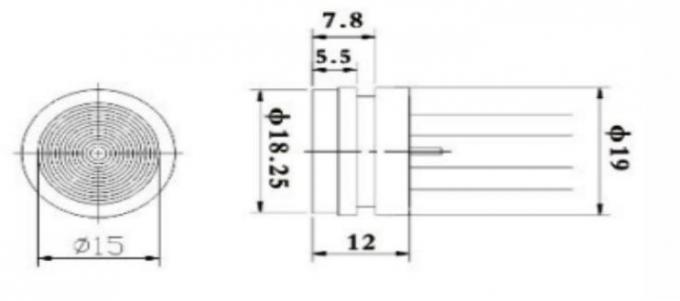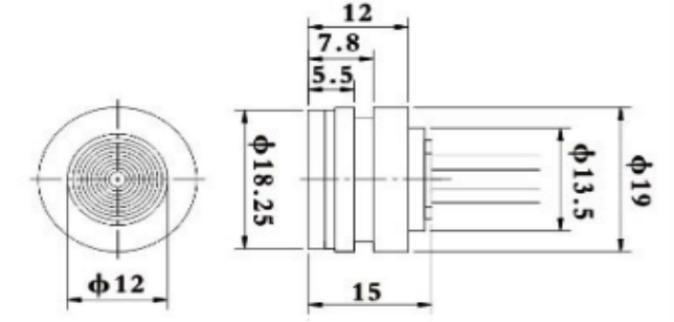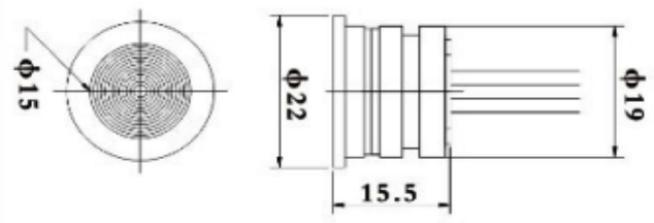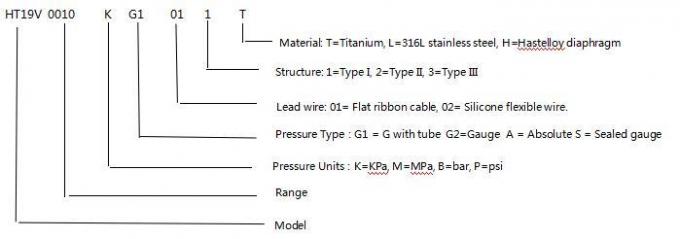Applications of silicon pressure sensor:
1. Suitable for measuring the corrosive gas and liquid pressure, compatible with 316 l stainless steel
2. Used in process control systems to monitor and control pressure.
3. Often used in refrigeration system and air compressor pressure measurement.
Electrical performance of silicon pressure sensor:
1.Power Supply: ≤10VDC
2.Common Mode Voltage Output: 50% of the input (typical)
3.Input Impedance:4KΩ~20KΩ
4.Output Impedance:2.5KΩ~6KΩ
5.Electrical Connection:100mm high-temperature wire,ribbon cable
| Performance Parameters of silicon pressure sensor:. |
| Measurement Range |
Gauge(G) |
10KPa,20KPa,35KPa,100KPa,200KPa,350KPa,1000KPa,2000Kpa |
| Absolute(A) |
100KPaA,200KPaA,350KPaA,700KPaA,1000KPaA,2000KPaA |
| Sealed(S) |
3500KPaS,7MPaS,10MPaS,20MPaS,40MPaS,60MPaS,100MPaS |
| |
Typ |
Max |
Unit |
| NonLinearity |
±0.15 |
±0.3 |
%F.S |
| Repeatability |
0.05 |
0.1 |
%F.S |
| Hysteresis |
0.05 |
0.1 |
%F.S |
| Zero Offset Output |
0±1 |
0±2 |
mV |
| Full Scale Output |
≤20KPa |
50±1 |
50±2 |
mV |
|
| ≥35kPa |
100±1 |
100±2 |
mV |
|
| Zero Offset Temp. Drift |
≤20KPa |
±1 |
±2.5 |
%F.S |
|
| ≥35kPa |
±0.8 |
±1.5 |
%F.S |
|
| Full Scale Temp. Drift |
≤20KPa |
±1 |
±2 |
%F.S |
|
| ≥35kPa |
±0.8 |
±1.5 |
%F.S |
|
| Compensated Temp. |
≤20KPa |
0~50 |
ºC |
|
| ≥35kPa |
0~70 |
ºC |
|
| Operating Temperature |
-20~80 |
ºC |
|
| Storage Temperature |
-40~125 |
ºC |
|
| Allowable Overload |
Take the smaller value between 3 times the full scale or 120MPa |
|
|
| Burst Pressure |
5X the full scale |
|
|
| Long-term Stability |
0.2 % |
F.S/Year |
|
| Diaphragm Material |
316L |
|
|
| Insulation Resistance |
≥200MΩ 100VDC |
|
|
| Vibration |
No change under conditions of 10gRMS, 20Hz to 2000Hz |
|
|
| Shock |
100g,11ms |
|
|
| Response Time |
≤1ms |
|
|
| O-ring Seal |
Nitrile rubber or Fluoro rubber |
|
|
| Filling Medium |
Silicon Oil |
|
|
| Weight |
~28g |
|
|
| The parameters are tested under the following conditions: 10V @ 25ºC |
|
| Outline Construction of silicon pressure sensor |
| <3.5MPaS |
 |
≥3.5MPaS
<40MPaS |
 |
| ≥40MPaS |
 |
| Electrical connection and compensation of silicon pressure sensor |
|

|

1. During assembly, attention should be paid to the coordination between the core size and the transmitter housing to achieve the required tightness.
2. When assembling the housing, ensure that it is vertically aligned and apply pressure evenly to avoid damaging the compensation plate.
3. If the measured medium is not compatible with the core diaphragm and housing material (316L), special instructions should be provided when placing the order.
4. Avoid pressing the sensor diaphragm with your hands or sharp objects to avoid deformation or puncture of the diaphragm and damage to the core.
5. Keep the pressure port of the gauge pressure core open to the atmosphere to prevent water, water vapor or corrosive media into the negative pressure chamber of the gauge pressure core.
1. What is a pressure sensor?
A pressure sensor is a device that measures the pressure of gases or liquids. It converts the physical pressure into an electrical signal that can be read and processed by control systems or monitoring equipment.
2. How does a pressure sensor work?
Pressure sensors operate by using different technologies, such as piezoresistive, capacitive, or piezoelectric elements, to detect changes in pressure. When pressure is applied, it causes a change in the physical properties of the sensing element, which is then converted into an electrical signal proportional to the pressure.
3. What are the types of pressure sensors?
Piezoresistive Pressure Sensors: Use the piezoresistive effect in materials like silicon to measure pressure.
Capacitive Pressure Sensors: Measure changes in capacitance caused by the deformation of a diaphragm under pressure.
Piezoelectric Pressure Sensors: Use materials that generate an electrical charge in response to applied mechanical stress.
Optical Pressure Sensors: Utilize light modulation to measure pressure changes.
Resonant Pressure Sensors: Measure pressure by detecting changes in the resonant frequency of a sensing element.

 Your message must be between 20-3,000 characters!
Your message must be between 20-3,000 characters! Please check your E-mail!
Please check your E-mail!  Your message must be between 20-3,000 characters!
Your message must be between 20-3,000 characters! Please check your E-mail!
Please check your E-mail! 






